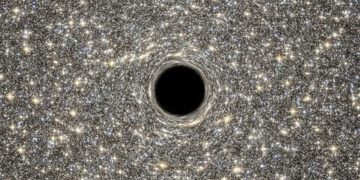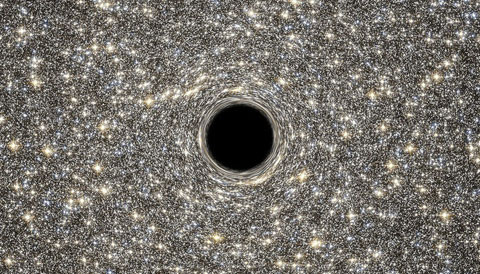Black holes have long been the universe’s most enigmatic objects, defying our understanding of physics and sparking endless curiosity. For decades, scientists have wondered: What lies inside a black hole? Now, a groundbreaking study led by physicist Enrico Rinaldi at the University of Michigan has brought us closer than ever to answering this question.
The Breakthrough: What Did Scientists Discover?
The study suggests that black holes may not be singularities but instead highly structured quantum states governed by new laws of physics. Using quantum matrix models, Rinaldi’s team simulated the lowest energy state of a black hole’s core. Their findings, published in PRX Quantum, reveal that black holes could be complex quantum systems rather than infinitely dense points.
This challenges the traditional view of black holes as singularities, where gravity becomes infinite and the laws of physics break down. Instead, the research suggests that black holes have a structured interior, governed by principles we are only beginning to understand.
How Quantum Computing and Machine Learning Made This Possible
Quantum computing and machine learning have enabled physicists to solve equations that were previously too complex to handle. The team used quantum circuits—networks of qubits (quantum bits)—to model black hole behavior.
Deep learning algorithms helped “tune” these circuits, allowing the simulation to evolve dynamically. Traditional methods couldn’t solve the complex equations required to model black holes, but quantum computing and AI have made it possible.
This marks a significant leap in computational physics, showcasing the power of advanced technology in tackling scientific mysteries. By leveraging these tools, scientists are now able to explore phenomena that were once beyond our reach, bringing us closer to understanding the universe’s deepest secrets.
The Holographic Principle: A New Way to Understand Black Holes
The study is based on the holographic principle, which suggests that gravity and quantum mechanics are mathematically equivalent but exist in different dimensions. According to this principle, gravity operates in three dimensions, while quantum mechanics functions in two dimensions. The two systems are mathematically equivalent, meaning that understanding one can help explain the other.
This principle implies that the information about a black hole’s interior is encoded on its event horizon, the boundary beyond which nothing can escape. Rather than being lost forever, this information could potentially be reconstructed.
What’s Inside a Black Hole? Rethinking the Singularity
The traditional view of black holes as singularities—points of infinite density—may be incomplete. The research suggests that black holes are not singularities but highly structured quantum states.
These states are governed by principles that we are only beginning to uncover. This new perspective challenges the idea that black holes destroy information. Instead, it suggests that information is stored on the event horizon, where it can be mathematically reconstructed.
Implications for Physics: Toward a Unified Theory of Quantum Gravity
This research brings us closer to reconciling quantum mechanics and general relativity, two fundamental but incompatible theories. Quantum mechanics explains the behavior of subatomic particles, while general relativity describes gravity and the curvature of spacetime.
The study shows that quantum systems can replicate gravitational behavior, suggesting a deeper connection between the two. A unified theory of quantum gravity would revolutionize our understanding of the universe, explaining phenomena like black holes, neutron stars, and even the Big Bang.
What’s Next? Future Directions in Black Hole Research
While this study is a major milestone, there is still much to explore. Future research will focus on expanding the models to simulate larger and more complex black holes, using more powerful quantum computers with greater numbers of qubits.
Scientists also plan to investigate whether these quantum models apply to other cosmic phenomena, such as neutron stars and wormholes.
Why This Matters: The Bigger Picture
This breakthrough is not just about black holes—it’s about understanding the universe itself. By challenging traditional views and leveraging cutting-edge technology, this research opens new avenues for exploring the cosmos.
It satisfies humanity’s innate curiosity about the universe’s most extreme environments and highlights the role of quantum computing and AI in solving complex scientific problems. Ultimately, this discovery could redefine our understanding of reality, information, and the nature of spacetime.
Conclusion: A New Era in Physics
The recent breakthrough in black hole research marks a turning point in our quest to understand the universe. By using quantum computing and machine learning, physicists have revealed that black holes may not be singularities but highly structured quantum states. This discovery not only challenges long-held assumptions but also brings us closer to a unified theory of quantum gravity.
Reference:
Quantum-mechanical Suppression of Accretion by Primordial Black Holes



















